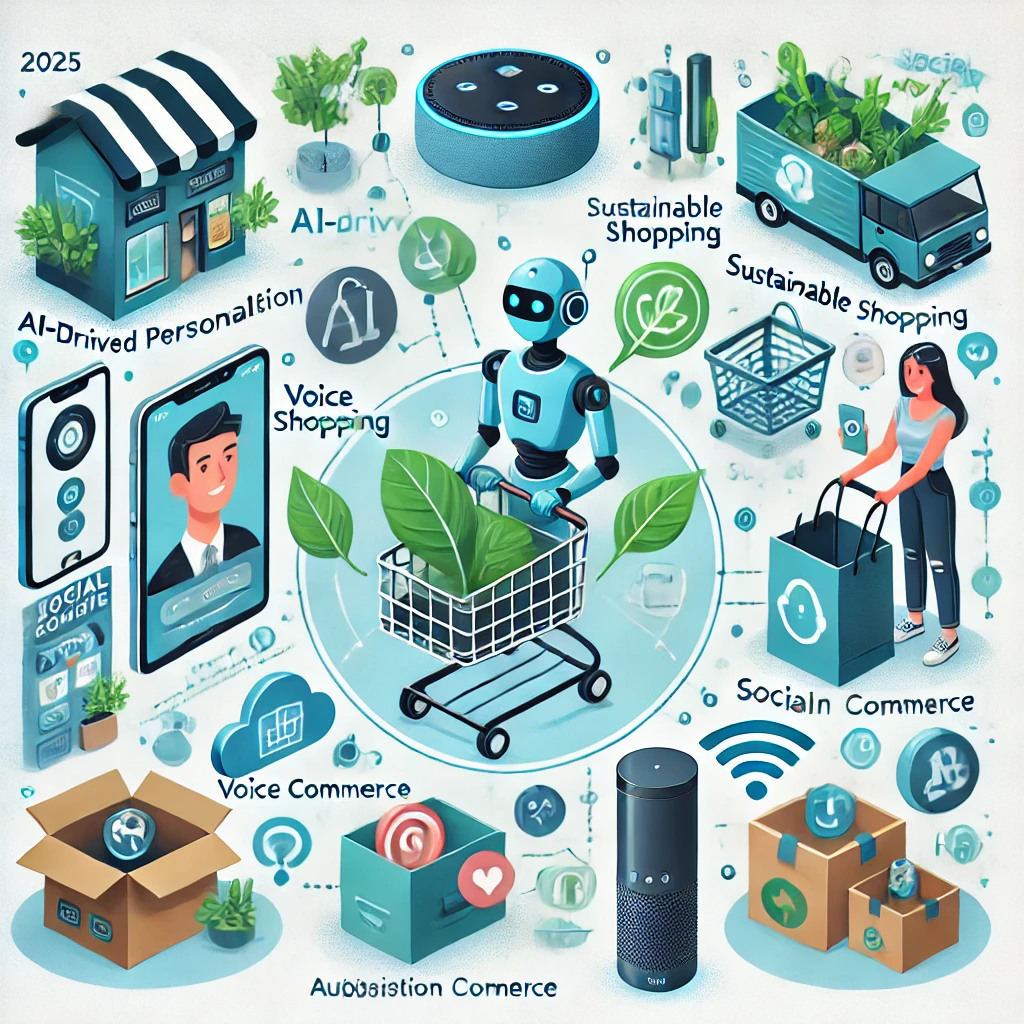The e-commerce landscape continues to evolve at an unprecedented pace, driven by advancements in technology and changing consumer behaviors. As we move into 2025, staying ahead of these trends is essential for businesses looking to thrive in the competitive online marketplace. In this blog, we’ll explore the top 7 e-commerce trends to watch in 2025, offering insights and strategies to help you adapt and grow.
AI-Driven Personalization
Artificial Intelligence (AI) continues to revolutionize e-commerce by enabling hyper-personalized shopping experiences. In 2025, AI will play an even more prominent role, offering:
- Tailored Recommendations: AI analyzes customer data to suggest products based on browsing history and preferences.
- Dynamic Pricing: AI adjusts prices in real-time based on demand, competition, and customer behavior.
- Enhanced Customer Support: AI-powered chatbots will provide instant, accurate assistance 24/7.
Key Strategy: Invest in AI tools to personalize customer interactions and streamline the shopping journey.
Sustainable and Ethical Shopping
Consumers are increasingly prioritizing sustainability and ethical practices in their purchasing decisions. In 2025, e-commerce brands will need to:
- Offer Eco-Friendly Products: Highlight sustainable materials and practices.
- Adopt Green Packaging: Reduce waste by using recyclable or biodegradable packaging.
- Promote Transparency: Clearly communicate ethical sourcing and production methods.
Key Strategy: Align your brand with eco-conscious values to attract and retain environmentally aware customers.
3. Voice Commerce Expansion
Voice commerce is set to become a dominant force in e-commerce as voice assistants like Alexa, Google Assistant, and Siri improve. Key developments include:
- Seamless Voice Search: Customers will search and shop using natural language.
- Voice-Activated Payments: Secure voice recognition technology will streamline transactions.
- Hands-Free Shopping: Voice commerce enhances convenience, especially for busy consumers.
Key Strategy: Optimize your website for voice search by incorporating long-tail keywords and conversational phrases.
4. Augmented Reality (AR) for Virtual Shopping
Augmented Reality (AR) will redefine how consumers shop online, bridging the gap between digital and physical experiences. AR applications in e-commerce include:
- Virtual Try-Ons: Customers can try clothes, accessories, or makeup virtually.
- Interactive Product Previews: Shoppers can visualize furniture or decor in their space before purchasing.
- Immersive Experiences: AR enables interactive and engaging shopping journeys.
Key Strategy: Leverage AR tools to reduce returns and enhance customer satisfaction by offering realistic product previews.
5. The Rise of Social Commerce
Social media platforms are evolving into full-fledged e-commerce hubs. In 2025, social commerce will thrive through:
- In-App Shopping: Platforms like Instagram, TikTok, and Pinterest enable direct purchases.
- Live Shopping Events: Influencers and brands host real-time shopping sessions.
- User-Generated Content: Authentic customer reviews and testimonials boost trust.
Key Strategy: Invest in social media marketing and collaborate with influencers to tap into social commerce opportunities.
6. Subscription-Based Models
Subscription-based models are gaining traction as customers value convenience and consistent deliveries. Examples include:
- Recurring Deliveries: Essentials like groceries, skincare, or pet supplies delivered regularly.
- Exclusive Memberships: Access to special deals, early product launches, or premium content.
- Personalized Bundles: Curated subscriptions based on customer preferences.
Key Strategy: Explore subscription services to build recurring revenue and foster customer loyalty.
7. Omnichannel Shopping Experiences
Consumers expect seamless shopping experiences across multiple channels. Omnichannel strategies in 2025 will emphasize:
- Unified Shopping Carts: Sync online and offline purchases for convenience.
- Click-and-Collect Options: Allow customers to order online and pick up in-store.
- Consistent Branding: Ensure cohesive messaging and aesthetics across platforms.
Key Strategy: Integrate your e-commerce store with physical locations and offer flexible delivery options.
Comparative Table of Trends
| Trend | Key Benefits | Implementation Tip |
|---|---|---|
| AI-Driven Personalization | Increases customer satisfaction and loyalty | Use AI-powered recommendation engines |
| Sustainable Shopping | Attracts eco-conscious customers | Adopt sustainable sourcing and packaging |
| Voice Commerce | Enhances convenience for busy shoppers | Optimize content for voice search |
| Augmented Reality (AR) | Reduces product returns | Integrate AR tools for virtual try-ons |
| Social Commerce | Boosts engagement and direct sales | Partner with influencers and run live events |
| Subscription-Based Models | Builds predictable revenue streams | Offer customizable subscription options |
| Omnichannel Shopping | Creates a seamless customer experience | Synchronize online and offline operations |
Conclusion
As we look ahead to 2025, the e-commerce landscape is poised for transformative changes. Businesses that embrace these trends—AI-driven personalization, sustainable shopping, voice commerce, AR, social commerce, subscription models, and omnichannel experiences—will position themselves for success in an increasingly competitive market. By staying agile and customer-focused, you can capitalize on these opportunities and ensure your e-commerce strategy remains relevant and effective.
FAQs
1. What is the biggest e-commerce trend in 2025?
AI-driven personalization is one of the biggest trends, as it enables highly tailored shopping experiences that boost customer satisfaction.
2. How can small businesses adopt sustainable e-commerce practices?
Small businesses can adopt sustainable practices by using eco-friendly packaging, sourcing ethically, and promoting transparency.
3. Why is voice commerce important for e-commerce?
Voice commerce enhances convenience by allowing customers to shop using voice commands, making it faster and more accessible.
4. What are the benefits of AR in e-commerce?
AR reduces product returns and improves customer satisfaction by enabling virtual try-ons and interactive product previews.
5. How can businesses succeed with social commerce?
To succeed with social commerce, businesses should leverage user-generated content, partner with influencers, and utilize in-app shopping features.

